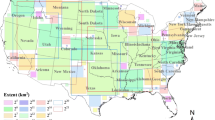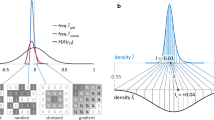Abstract
Understanding the relationship between pattern and scale is a central issue in landscape ecology. Pattern analysis is necessarily a critical step to achieve this understanding. Pattern and scale are inseparable in theory and in reality. Pattern occurs on different scales, and scale affects pattern to be observed. The objective of our study is to investigate how changing scale might affect the results of landscape pattern analysis using three commonly adopted spatial autocorrelation indices,i.e., Moran Coefficient, Geary Ratio, and Cliff-Ord statistic. The data sets used in this study are spatially referenced digital data sets of topography and biomass in 1972 of Peninsular Malaysia. Our results show that all three autocorrelation indices were scale-dependent. In other words, the degree of spatial autocorrelation measured by these indices vary with the spatial scale on which analysis was performed. While all the data sets show a positive spatial autocorrelation across a range of scales, Moran coefficient and Cliff-Ord statistic decrease and Geary Ratio increases with increasing grain size, indicating an overall decline in the degree of spatial autocorrelation with scale. The effect of changing scale varies in their magnitude and rate of change when different types of landscape data are used. We have also explored why this could happen by examining the formulation of the Moran coefficient. The pattern of change in spatial autocorrelation with scale exhibits threshold behavior,i.e., scale effects fade away after certain spatial scales are reached (for elevation). We recommend that multiple methods be used for pattern analysis whenever feasible, and that scale effects must be taken into account in all spatial analysis.
Similar content being viewed by others
References
Allen, T.F.H. and Starr, T.B. 1982. Hierarchy: Perspectives for Ecological Complexity. University of Chicago Press, Chicago.
Burgess, R.L. and Sharpe, D.M. (eds). 1981. Forest Island Dynamics in Man-Dominated Landscapes. Springer-Verlag, New York.
Brown, S., Iverson, L.R. and Lugo, A.E. 1994. Land use and biomass changes of forests in Peninsular Malaysia during 1972–1982: use of GIS analysis.In Effects of Land-Use Change on Atmospheric CO2 Concentrations: Southeast Asia as a Case Study, pp. 117–143. Edited by V. Dale. Springer-Verlag, New York.
Cliff, A. and Ord, J.K. 1973. Spatial Autocorrelation. Pion, London.
Cliff, A. and Ord, J.K. 1981. Spatial Process. Pion, London.
Costanza, R. and Maxwell, T. 1994. Resolution and predictability: An approach to the scaling problem. Landsc. Ecol. 9: 47–57.
Cullinan, V.I. and Thomas, J.M. 1992. A comparison of quantitative methods for examining landscape pattern and scale. Landsc. Ecol. 7: 211–227.
Forman, R.T.T. and Godron, M. 1986. Landscape ecology. Wiley, New York.
Fortin, M.-J., Drapeau, P. and Legendre, P. 1989. Spatial autocorrelation and sampling design in plant ecology. Vegetatio 83: 209–222.
Getis, A. and Boots, B. 1978. Models of spatial processes: an approach to the study of point, line and area patterns. Cambridge University Press, Cambridge, England.
Getis, A. and Ord, J.K. 1992. The analysis of spatial association by use of distance statistics. Geographical Analysis 24: 189–206.
Goodchild, M.F. 1986. Spatial Autocorrelation. Concepts and Techniques in Modern Geography 47, Geo Books, Norwich.
Greig-Smith, P. 1952. The use of random and contiguous quadrats in the study of the structure of plant communities. Ann. Bot., New Series 16: 293–316.
Griffith, D.A. 1988. Advanced Spatial Statistics. Special Topics in the Exploration of Quantitative Spatial Data Series. Kluwer Academic Publishers, Dordrecht.
Griffith, D.A. 1990. Supercomputing and spatial statistics: A reconnaissance. Prof. Geogr. 42(4): 481–492.
Kershaw, K.A. 1957. The use of cover and frequency in the detection of pattern in plant communities. Ecology 38: 291–299.
Legendre, P. 1993. Spatial autocorrelation: trouble or new paradigm? Ecology 74: 1659–1673.
Legendre, P. and Fortin, M. J. 1989. Spatial pattern and ecological analysis. Vegetatio 80: 107–138.
Levin, S.A. 1992. The problem of pattern and scale in ecology. Ecology 73: 1943–1967.
Levin, S.A., Powell, T. and Steele, J.H. (eds.) 1993. Patch Dynamics. Springer-Verlag, New York.
Meentemeyer, V. and Box, E.O. 1987. Scale effects in landscape studies.In Landscape Heterogeneity and Disturbance. pp. 15–34. Edited by M.G. Turner. Springer-Verlag, New York.
Milne, B.T. 1988. Measuring the fractal geometry of landscapes. Appl. Math. Comp. 27: 67–79.
Morris, D.W. 1987. Ecological scale and habitat use. Ecology 68: 362–369.
Nellis, M.D. and Briggs, J.M. 1989. The effect of spatial scale on Konza landscape classification using textural analysis. Landsc. Ecol. 3: 93–100.
Odland, J. Spatial Autocorrelation. SAGE Publications, Newbury Park.
O'Neill, R.V., DeAngelis, D.L., Waide, J.B. and Allen, T.F.H. 1986. A Hierarchical Concept of Ecosystems. Princeton University Press, Princeton.
O'Neill, R.V., Krummel, J.R., Gardner, R.H., Sugihara, G., Jackson, B., DeAngelis, D.L., Milne, B.T., Turner, M.G., Zygmunt, B., Chistensen, S., Dale, V.H. and Graham, R.L. 1988. Indices of landscape pattern. Landsc. Ecol. 1: 153–162.
Opdam, P. 1991. Metapopulation theory and habitat fragmentation: A review of holarctic breeding bird studies. Landsc. Ecol. 5: 93–106.
Risser, P.G., Karr, J.R. and Forman, R.T.T. 1984. Landscape Ecology: Directions and Approaches. Illinois Natural History Survey, Special Publication Number 2.
Turner, M.G., Dale, V.H. and Gardner, R.H. 1989. Predicting across scales: theory development and testing. Landsc. Ecol. 3: 245–252.
Turner, M.G. and Gardner, R.H. (eds). 1991. Quantitative Methods in Landscape Ecology. Springer-Verlag, New York.
Turner, M.G., O'Neill, R.V., Gardner, R.H. and Milne, B.T. 1989. Effects of changing spatial scale on the analysis of landscape pattern. Landsc. Ecol. 3: 153–162.
Wiens, J.A. and Milne, B.T. 1989. Scaling of “landscape” in landscape ecology, or, landscape ecology from a beetle's perspective. Landsc. Ecol. 3: 87–96.
Wiens, J.A., Stenseth, N.C., Horne, B. van and Ims, R.A. 1993. Ecological mechanisms and landscape ecology. Oikos 66: 369–380.
Wu, J. 1992a. Detecting spatial patterns: the net-function interpolation. Coenoses 7(3): 137–143.
Wu, J. 1992b. Balance of nature and environmental protection: A paradigm shift. Proc. 4th Intern. Conf. Asia Experts. Portland State University, Portland, OR, May 7–8, 1992.
Wu, J., Jelinski, D. and Qi, Y. 1994. Spatial pattern analysis of a boreal forest landscape: Scale effects and interpretation.Proc. VI Intern. Conf. Ecology (INTECOL), pp. 165. Univ. of Manchester, Manchester, August 21–26, 1994.
Wu, J. and Levin, S.A. 1994. A spatial patch dynamic modeling approach to pattern and process in an annual grassland. Ecol. Monogr. 64(4): 447–464.
Wu, J., Li, B. and Wu, Y. 1992. Patchiness and patch dynamics: I. Concepts and mechanisms. Chin. J. Ecol. 11(4): 41–45.
Wu, J. and Vankat, J.L. 1991a. A system dynamics model of island biogeography. Bull. Math. Biol. 53: 911–930.
Wu, J. and Vankat, J.L. 1991b. An area-based model of species richness dynamics of forest islands. Ecol. Modell. 58: 249–271.
Wu, J. and Vankat, J.L. 1995. Island biogeography: Theory and applications.In Encyclopedia of Environmental Biology. Edited by W.A. Nierenberg: Academic Press (in press).
Wu, J., Vankat, J.L. and Barlas, B. 1993. Effects of patch connectivity and arrangement on animal metapopulation dynamics: a simulation study. Ecol. Modell. 65: 221–254.
Zonneveld, I.S. and Forman, R.T.T. (eds). 1990. Changing Landscapes: An Ecological Perspective. Springer-Verlag, New York.
Author information
Authors and Affiliations
Corresponding author
Rights and permissions
About this article
Cite this article
Qi, Y., Wu, J. Effects of changing spatial resolution on the results of landscape pattern analysis using spatial autocorrelation indices. Landscape Ecol 11, 39–49 (1996). https://doi.org/10.1007/BF02087112
Issue Date:
DOI: https://doi.org/10.1007/BF02087112




